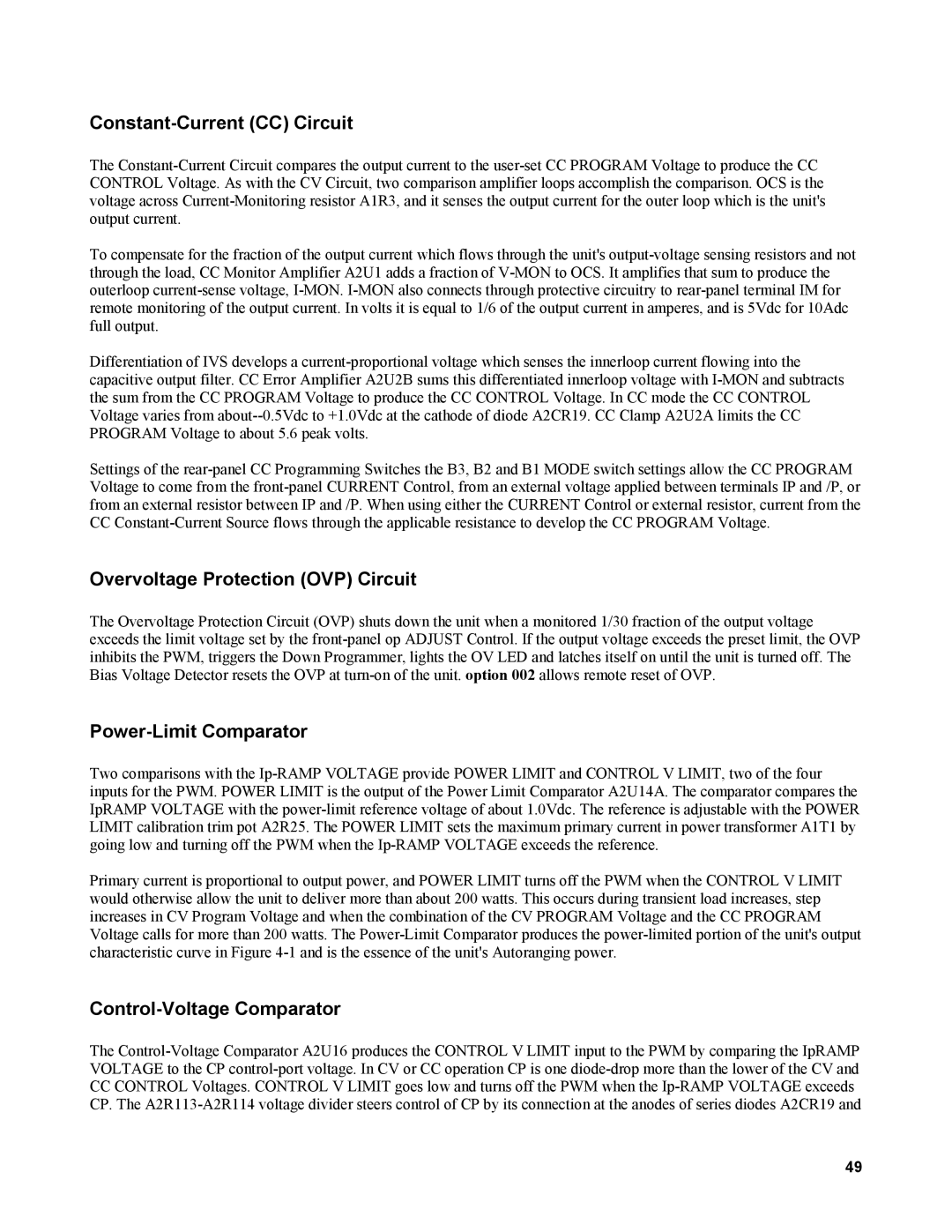Constant-Current (CC) Circuit
The Constant-Current Circuit compares the output current to the user-set CC PROGRAM Voltage to produce the CC CONTROL Voltage. As with the CV Circuit, two comparison amplifier loops accomplish the comparison. OCS is the voltage across Current-Monitoring resistor A1R3, and it senses the output current for the outer loop which is the unit's output current.
To compensate for the fraction of the output current which flows through the unit's output-voltage sensing resistors and not through the load, CC Monitor Amplifier A2U1 adds a fraction of V-MON to OCS. It amplifies that sum to produce the outerloop current-sense voltage, I-MON. I-MON also connects through protective circuitry to rear-panel terminal IM for remote monitoring of the output current. In volts it is equal to 1/6 of the output current in amperes, and is 5Vdc for 10Adc full output.
Differentiation of IVS develops a current-proportional voltage which senses the innerloop current flowing into the capacitive output filter. CC Error Amplifier A2U2B sums this differentiated innerloop voltage with I-MON and subtracts the sum from the CC PROGRAM Voltage to produce the CC CONTROL Voltage. In CC mode the CC CONTROL Voltage varies from about--0.5Vdc to +1.0Vdc at the cathode of diode A2CR19. CC Clamp A2U2A limits the CC PROGRAM Voltage to about 5.6 peak volts.
Settings of the rear-panel CC Programming Switches the B3, B2 and B1 MODE switch settings allow the CC PROGRAM Voltage to come from the front-panel CURRENT Control, from an external voltage applied between terminals IP and /P, or from an external resistor between IP and /P. When using either the CURRENT Control or external resistor, current from the CC Constant-Current Source flows through the applicable resistance to develop the CC PROGRAM Voltage.
Overvoltage Protection (OVP) Circuit
The Overvoltage Protection Circuit (OVP) shuts down the unit when a monitored 1/30 fraction of the output voltage exceeds the limit voltage set by the front-panel op ADJUST Control. If the output voltage exceeds the preset limit, the OVP inhibits the PWM, triggers the Down Programmer, lights the OV LED and latches itself on until the unit is turned off. The Bias Voltage Detector resets the OVP at turn-on of the unit. option 002 allows remote reset of OVP.
Power-Limit Comparator
Two comparisons with the Ip-RAMP VOLTAGE provide POWER LIMIT and CONTROL V LIMIT, two of the four inputs for the PWM. POWER LIMIT is the output of the Power Limit Comparator A2U14A. The comparator compares the IpRAMP VOLTAGE with the power-limit reference voltage of about 1.0Vdc. The reference is adjustable with the POWER LIMIT calibration trim pot A2R25. The POWER LIMIT sets the maximum primary current in power transformer A1T1 by going low and turning off the PWM when the Ip-RAMP VOLTAGE exceeds the reference.
Primary current is proportional to output power, and POWER LIMIT turns off the PWM when the CONTROL V LIMIT would otherwise allow the unit to deliver more than about 200 watts. This occurs during transient load increases, step increases in CV Program Voltage and when the combination of the CV PROGRAM Voltage and the CC PROGRAM Voltage calls for more than 200 watts. The Power-Limit Comparator produces the power-limited portion of the unit's output characteristic curve in Figure 4-1 and is the essence of the unit's Autoranging power.
Control-Voltage Comparator
The Control-Voltage Comparator A2U16 produces the CONTROL V LIMIT input to the PWM by comparing the IpRAMP VOLTAGE to the CP control-port voltage. In CV or CC operation CP is one diode-drop more than the lower of the CV and
CCCONTROL Voltages. CONTROL V LIMIT goes low and turns off the PWM when the Ip-RAMP VOLTAGE exceeds CP. The A2R113-A2R114 voltage divider steers control of CP by its connection at the anodes of series diodes A2CR19 and
